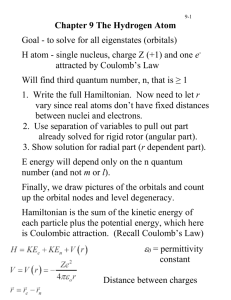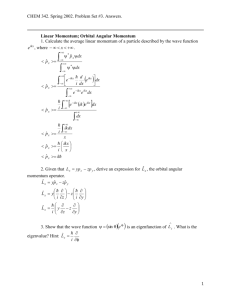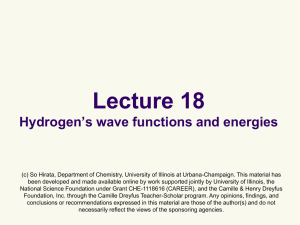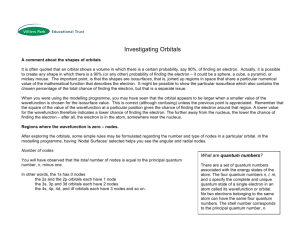L13_2Dwave
advertisement
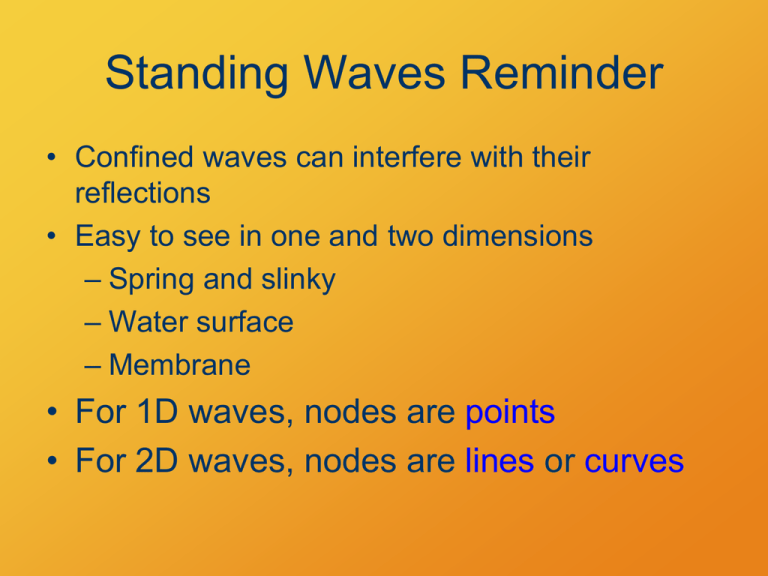
Standing Waves Reminder • Confined waves can interfere with their reflections • Easy to see in one and two dimensions – Spring and slinky – Water surface – Membrane • For 1D waves, nodes are points • For 2D waves, nodes are lines or curves Rectangular Potential b U=∞ U=0 0 0 a • Solutions y(x,y) = A sin(nxpx/a) sin(nypy/b) • Variables separate y = X(x) · Y(y) • Energies p2h2 2m nx a 2 + ny b 2 Square Potential a U=∞ U=0 0 0 a • Solutions y(x,y) = A sin(nxpx/a) sin(nypy/a) 2h2 p 2 + n 2 • Energies n y 2ma2 x Combining Solutions • Schrodinger Equation Uy – (h2/2M)y = Ey • Wave functions giving the same E (degenerate) can combine in any linear combination to satisfy the equation A1y1 + A2y2 + ··· Square Potential • Solutions interchanging nx and ny are degenerate • Examples: nx = 1, ny = 2 vs. nx = 2, ny = 1 – + + – Linear Combinations • y1 = sin(px/a) sin(2py/a) – + • y2 = sin(2px/a) sin(py/a) + – y1 + y2 – + y1 – y2 – y2 – y1 + + – –y1 – y2 – + Verify Diagonal Nodes y1 = sin(px/a) sin(2py/a) y2 = sin(2px/a) sin(py/a) y1 – y2 y1 + y2 – + – + Node at y = x Node at y = a – x Circular membrane • Nodes are lines Circular membrane standing waves edge node only diameter node circular node Source: Dan Russel’s page • Higher frequency more nodes Types of node • radial • angular 3D Standing Waves • Classical waves – Sound waves – Microwave ovens • Nodes are surfaces Hydrogen Atom • Potential is spherically symmetrical • Variables separate in spherical polar coordinates z q r y f x Quantization Conditions • Must match after complete rotation in any direction – angles q and f • Must go to zero as r ∞ • Requires three quantum numbers We Expect • Oscillatory in classically allowed region (near nucleus) • Decays in classically forbidden region • Radial and angular nodes Electron Orbitals • Higher energy more nodes • Exact shapes given by three quantum numbers n, l, ml • Form ynlm(r, q, f) = Rnl(r)Ylm(q, f) Radial Part R ynlm(r, q, f) = Rnl(r)Ylm(q, f) Three factors: 1. Normalizing constant (Z/aB)3/2 2. Polynomial in r of degree n–1 (p. 279) 3. Decaying exponential e–r/aBn Angular Part Y ynlm(r, q, f) = Rnl(r)Ylm(q, f) Three factors: 1. Normalizing constant 2. Degree l sines and cosines of q (associated Legendre functions, p.269) 3. Oscillating exponential eimf Hydrogen Orbitals Source: Chem Connections “What’s in a Star?” http://chemistry.beloit.edu/Stars/pages/orbitals.html Energies • E = –ER/n2 • Same as Bohr model Quantum Number n • • • • n: 1 + Number of nodes in orbital Sets energy level Values: 1, 2, 3, … Higher n → more nodes → higher energy Quantum Number l • • • • l: angular momentum quantum number Number of angular nodes Values: 0, 1, …, n–1 Sub-shell or orbital type l orbital type 0 1 2 3 s p d f Quantum number ml • z-component of angular momentum Lz = mlh • Values: –l,…, 0, …, +l • Tells which specific orbital (2l + 1 of them) in the sub-shell l 0 1 2 3 orbital type degeneracy s p d f 1 3 5 7 Angular momentum • • • • L = [l(l+1)]1/2 h Total angular momentum is quantized Lz = mlh z-component of L is quantized in increments of h • But the minimum magnitude is 0, not h Radial Probability Density • P(r) = probability density of finding electron at distance r • |y|2dV is probability in volume dV • For spherical shell, dV = 4pr2dr • P(r) = 4pr2|R(r)|2 Radial Probability Density Radius of maximum probability • For 1s, r = aB • For 2p, r = 4aB • For 3d, r = 9aB (Consistent with Bohr orbital distances) Quantum Number ms • Spin direction of the electron • Only two values: ± 1/2
